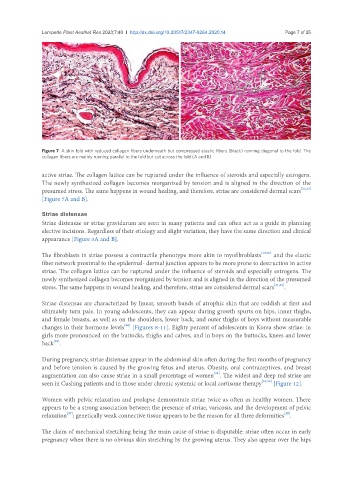Page 438 - Read Online
P. 438
Lemperle Plast Aesthet Res 2020;7:40 I http://dx.doi.org/10.20517/2347-9264.2020.14 Page 7 of 25
A B
Figure 7. A skin fold with reduced collagen fibers underneath but compressed elastic fibers (black) running diagonal to the fold. The
collagen fibers are mainly running parallel to the fold but cut across the fold (A and B)
active striae. The collagen lattice can be ruptured under the influence of steroids and especially estrogens.
The newly synthesized collagen becomes reorganized by tension and is aligned in the direction of the
presumed stress. The same happens in wound healing, and therefore, striae are considered dermal scars [21,22]
[Figure 7A and B].
Striae distensae
Striae distensae or striae gravidarum are seen in many patients and can often act as a guide in planning
elective incisions. Regardless of their etiology and slight variation, they have the same direction and clinical
appearance [Figure 3A and B].
The fibroblasts in striae possess a contractile phenotype more akin to myofibroblasts [19,20] and the elastic
fiber network proximal to the epidermal- dermal junction appears to be more prone to destruction in active
striae. The collagen lattice can be ruptured under the influence of steroids and especially estrogens. The
newly synthesized collagen becomes reorganized by tension and is aligned in the direction of the presumed
stress. The same happens in wound healing, and therefore, striae are considered dermal scars [21,22] .
Striae distensae are characterized by linear, smooth bands of atrophic skin that are reddish at first and
ultimately turn pale. In young adolescents, they can appear during growth spurts on hips, inner thighs,
and female breasts, as well as on the shoulders, lower back, and outer thighs of boys without measurable
[22]
changes in their hormone levels [Figures 8-11]. Eighty percent of adolescents in Korea show striae: in
girls more pronounced on the buttocks, thighs and calves, and in boys on the buttocks, knees and lower
[23]
back .
During pregnancy, striae distensae appear in the abdominal skin often during the first months of pregnancy
and before tension is caused by the growing fetus and uterus. Obesity, oral contraceptives, and breast
[24]
augmentation can also cause striae in a small percentage of women . The widest and deep red striae are
seen in Cushing patients and in those under chronic systemic or local cortisone therapy [25,26] [Figure 12].
Women with pelvic relaxation and prolapse demonstrate striae twice as often as healthy women. There
appears to be a strong association between the presence of striae, varicosis, and the development of pelvic
[28]
[27]
relaxation ; genetically weak connective tissue appears to be the reason for all three deformities .
The claim of mechanical stretching being the main cause of striae is disputable: striae often occur in early
pregnancy when there is no obvious skin stretching by the growing uterus. They also appear over the hips

